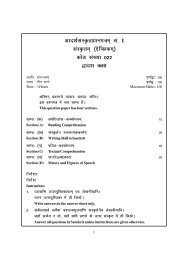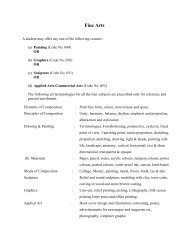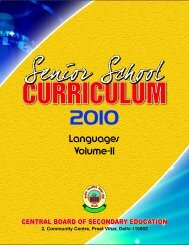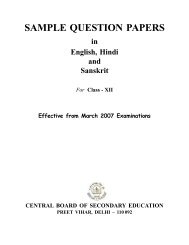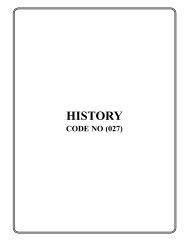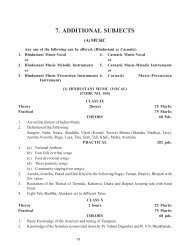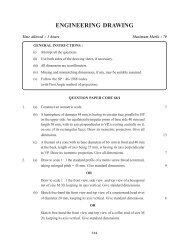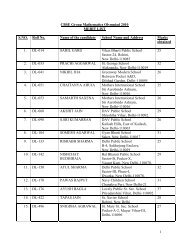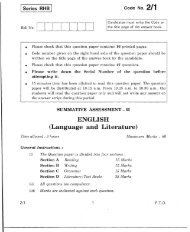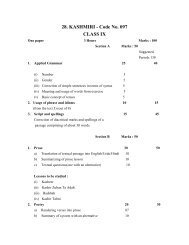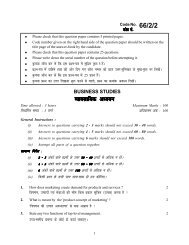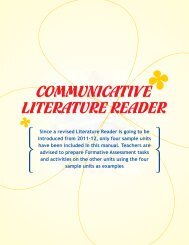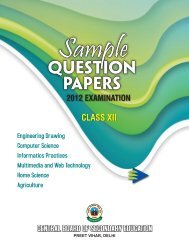A Text Book on Engineering Graphics - Central Board of Secondary ...
A Text Book on Engineering Graphics - Central Board of Secondary ...
A Text Book on Engineering Graphics - Central Board of Secondary ...
Create successful ePaper yourself
Turn your PDF publications into a flip-book with our unique Google optimized e-Paper software.
ROD JOINTS<br />
KNUCKLE JOINT OR PIN JOINT<br />
A knuckle joint is generally used to c<strong>on</strong>nect rods not positi<strong>on</strong>ed in a straight line and subjected to<br />
axial tensile load. This joint is not rigid. Sometimes, if it is required to be used to support<br />
compressive loading, a guide may be provided to c<strong>on</strong>strain the moti<strong>on</strong> <strong>of</strong> two fastened<br />
comp<strong>on</strong>ents (rods). In this joint the end <strong>of</strong> <strong>on</strong>e rod is forged to form an eye while the other is made<br />
in the form <strong>of</strong> a fork having double eyes and this is called as eye end and fork end respectively. Eye<br />
end is inserted in fork end and a cylindrical pin is inserted through comm<strong>on</strong> holes in them. The<br />
cylindrical pin is kept in positi<strong>on</strong> by a round collar through which a transverse taper pin is<br />
inserted. The rods are quite free to rotate about the cylindrical pin. The end <strong>of</strong> the rods is made<br />
rectangular to some distance for firm grip and then these are made into a hexag<strong>on</strong>al or octag<strong>on</strong>al<br />
in shape (for an easy adjustment with the help <strong>of</strong> a spanner or a wrench), before it is forged into<br />
eye and fork shapes. This type <strong>of</strong> joint is widely used in practice to c<strong>on</strong>nect rods, which, for<br />
various reas<strong>on</strong>s, cannot be fitted with a rigid joint. It is comm<strong>on</strong>ly used when a reciprocating<br />
moti<strong>on</strong> is to be c<strong>on</strong>verted into a rotary moti<strong>on</strong> or vice-versa. This joint is used for c<strong>on</strong>necting Dslide<br />
valve, and eccentric rod <strong>of</strong> a steam engine, air brake <strong>of</strong> locomotives and many kinds <strong>of</strong> levers<br />
and rod c<strong>on</strong>necti<strong>on</strong>s, tie bars <strong>of</strong> trusses, links <strong>of</strong> suspensi<strong>on</strong> chains and many other links. The<br />
knuckle joint is also used for fastening more than two rods intersecting at a single points.<br />
COLLAR<br />
TAPER PIN<br />
EYE END<br />
KNUCKLE - JOINT<br />
ASSEMBLY<br />
36<br />
CIRCULAR<br />
PIN<br />
EYE END<br />
30<br />
30<br />
80<br />
Ø50<br />
FORK END<br />
KUNCKLE PIN<br />
PIN<br />
TAPER 1 IN 30<br />
COLLAR<br />
KNUCKLE JOINT OR PIN JOINT PARTS<br />
ENGINEERING GRAPHICS 121<br />
Ø40<br />
Fig: 4.17<br />
14<br />
Ø50<br />
90<br />
20<br />
30 20<br />
30<br />
Ø40<br />
14<br />
FORK END<br />
R15<br />
105<br />
1235<br />
Ø25



